Energy and Sustainability Report: COP 21, Fracking, Renewable Energy
VerifiedAdded on 2020/12/09
|19
|5013
|367
Report
AI Summary
This report provides a comprehensive analysis of energy and sustainability issues, focusing on the challenges and decisions made during COP 21, life cycle assessments of fracking activities in the US and UK, and the social, financial, and environmental impacts of developing renewable energy technologies in India. The report critically evaluates the challenges following key decisions made during COP 21, such as non-binding commitments and lack of enforcement, and the effects on global temperature. It offers recommendations on life cycle assessments of fracking, emphasizing the need for environmental impact assessments and green chemistry practices. The report further explores political and financial incentives for energy efficiency in housing and transport and evaluates the impacts of renewable energy development in India, offering insights into the complexities and potential solutions for sustainable energy practices. The report concludes with a summary of the findings and recommendations, providing a valuable resource for understanding the current state and future directions of sustainable energy development.
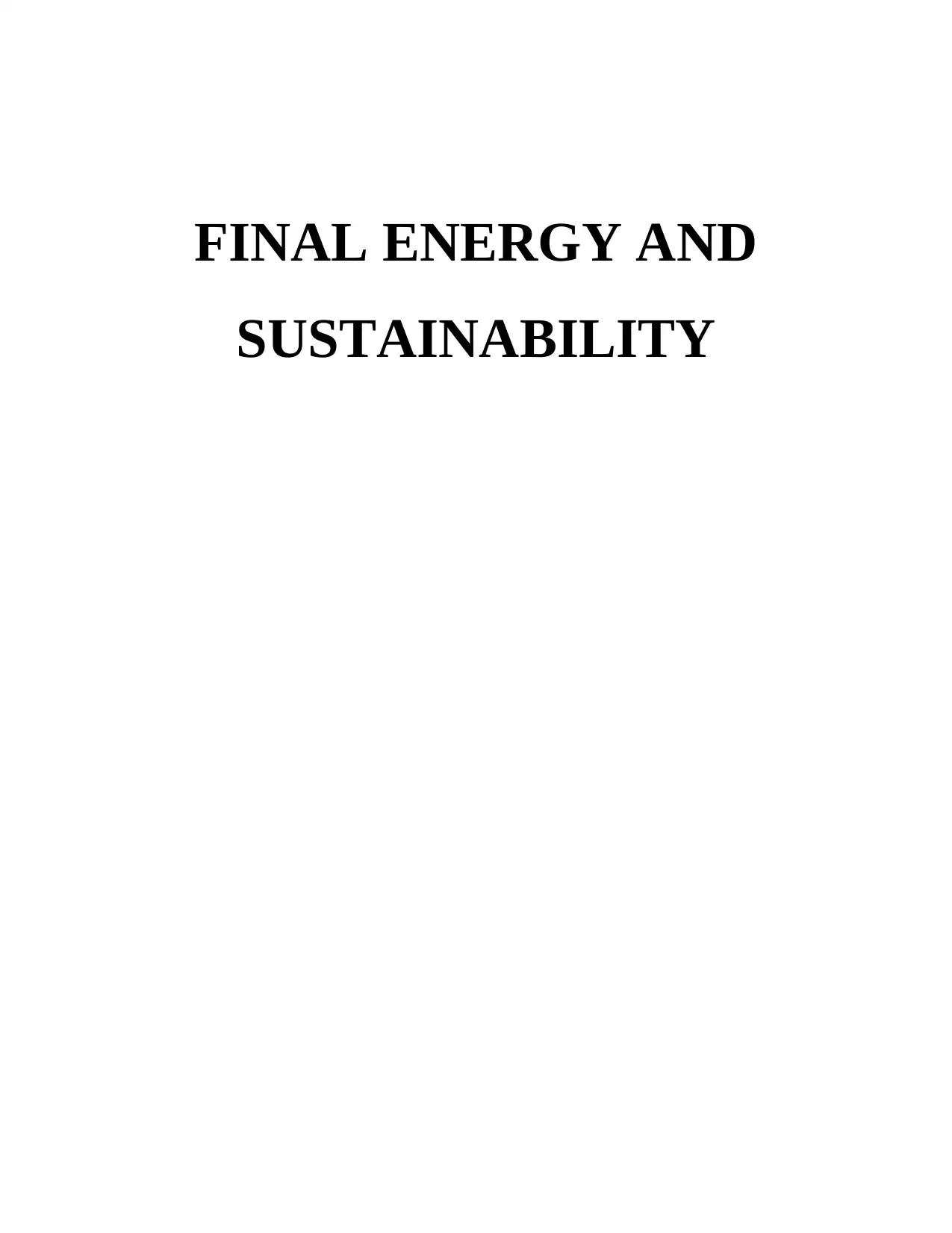
FINAL ENERGY AND
SUSTAINABILITY
SUSTAINABILITY
Paraphrase This Document
Need a fresh take? Get an instant paraphrase of this document with our AI Paraphraser
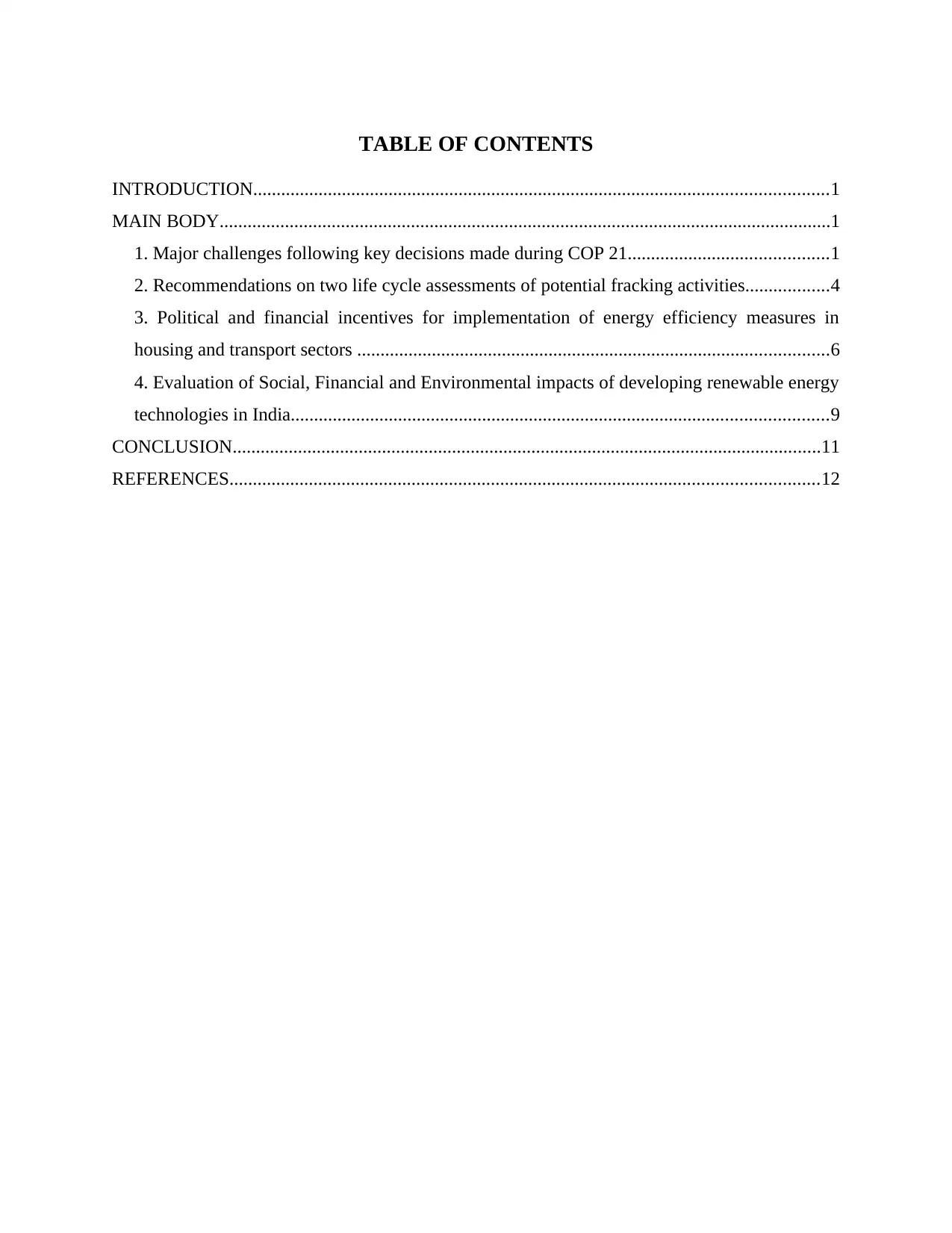
TABLE OF CONTENTS
INTRODUCTION...........................................................................................................................1
MAIN BODY...................................................................................................................................1
1. Major challenges following key decisions made during COP 21...........................................1
2. Recommendations on two life cycle assessments of potential fracking activities..................4
3. Political and financial incentives for implementation of energy efficiency measures in
housing and transport sectors .....................................................................................................6
4. Evaluation of Social, Financial and Environmental impacts of developing renewable energy
technologies in India...................................................................................................................9
CONCLUSION..............................................................................................................................11
REFERENCES..............................................................................................................................12
INTRODUCTION...........................................................................................................................1
MAIN BODY...................................................................................................................................1
1. Major challenges following key decisions made during COP 21...........................................1
2. Recommendations on two life cycle assessments of potential fracking activities..................4
3. Political and financial incentives for implementation of energy efficiency measures in
housing and transport sectors .....................................................................................................6
4. Evaluation of Social, Financial and Environmental impacts of developing renewable energy
technologies in India...................................................................................................................9
CONCLUSION..............................................................................................................................11
REFERENCES..............................................................................................................................12
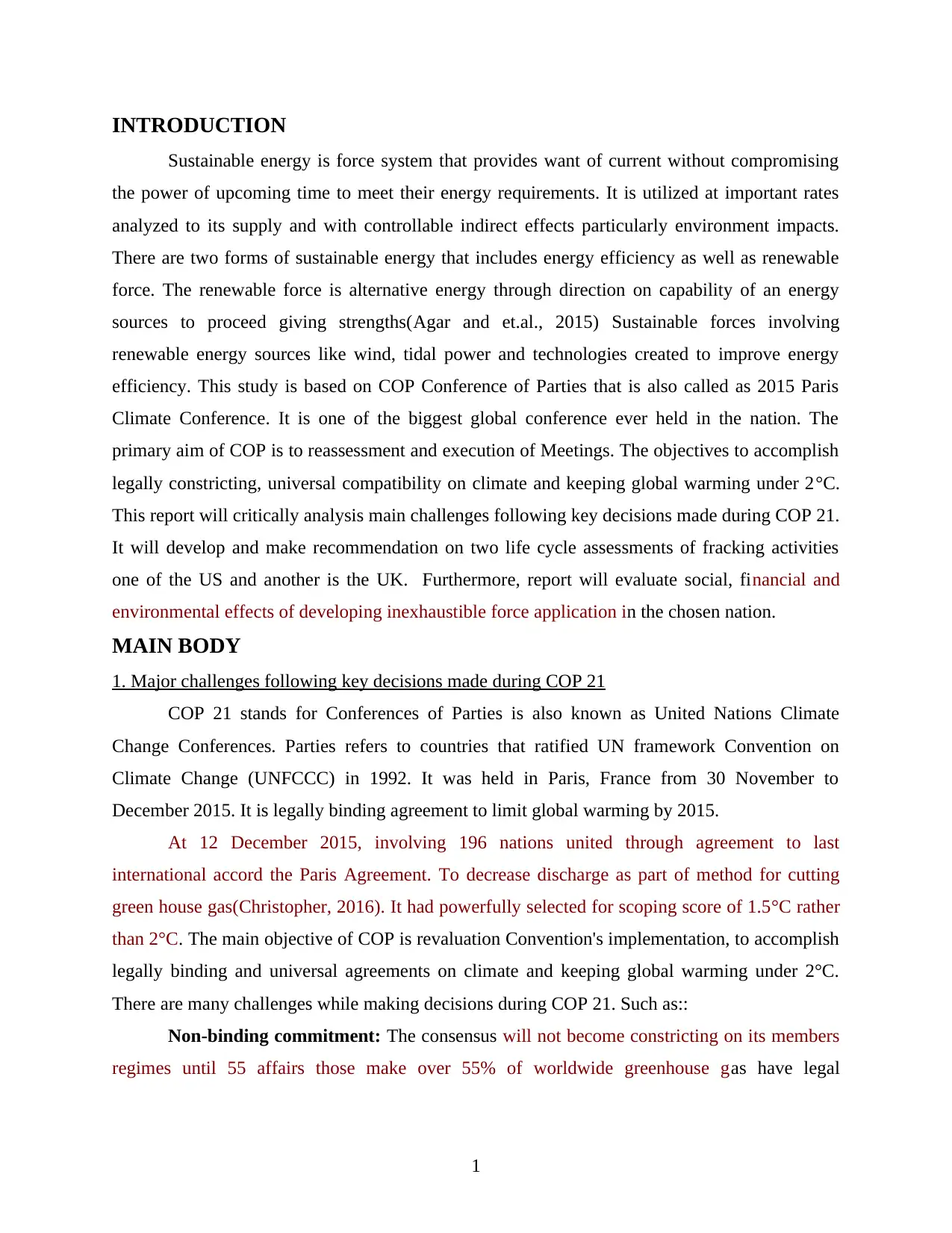
INTRODUCTION
Sustainable energy is force system that provides want of current without compromising
the power of upcoming time to meet their energy requirements. It is utilized at important rates
analyzed to its supply and with controllable indirect effects particularly environment impacts.
There are two forms of sustainable energy that includes energy efficiency as well as renewable
force. The renewable force is alternative energy through direction on capability of an energy
sources to proceed giving strengths(Agar and et.al., 2015) Sustainable forces involving
renewable energy sources like wind, tidal power and technologies created to improve energy
efficiency. This study is based on COP Conference of Parties that is also called as 2015 Paris
Climate Conference. It is one of the biggest global conference ever held in the nation. The
primary aim of COP is to reassessment and execution of Meetings. The objectives to accomplish
legally constricting, universal compatibility on climate and keeping global warming under 2°C.
This report will critically analysis main challenges following key decisions made during COP 21.
It will develop and make recommendation on two life cycle assessments of fracking activities
one of the US and another is the UK. Furthermore, report will evaluate social, financial and
environmental effects of developing inexhaustible force application in the chosen nation.
MAIN BODY
1. Major challenges following key decisions made during COP 21
COP 21 stands for Conferences of Parties is also known as United Nations Climate
Change Conferences. Parties refers to countries that ratified UN framework Convention on
Climate Change (UNFCCC) in 1992. It was held in Paris, France from 30 November to
December 2015. It is legally binding agreement to limit global warming by 2015.
At 12 December 2015, involving 196 nations united through agreement to last
international accord the Paris Agreement. To decrease discharge as part of method for cutting
green house gas(Christopher, 2016). It had powerfully selected for scoping score of 1.5°C rather
than 2°C. The main objective of COP is revaluation Convention's implementation, to accomplish
legally binding and universal agreements on climate and keeping global warming under 2°C.
There are many challenges while making decisions during COP 21. Such as::
Non-binding commitment: The consensus will not become constricting on its members
regimes until 55 affairs those make over 55% of worldwide greenhouse gas have legal
1
Sustainable energy is force system that provides want of current without compromising
the power of upcoming time to meet their energy requirements. It is utilized at important rates
analyzed to its supply and with controllable indirect effects particularly environment impacts.
There are two forms of sustainable energy that includes energy efficiency as well as renewable
force. The renewable force is alternative energy through direction on capability of an energy
sources to proceed giving strengths(Agar and et.al., 2015) Sustainable forces involving
renewable energy sources like wind, tidal power and technologies created to improve energy
efficiency. This study is based on COP Conference of Parties that is also called as 2015 Paris
Climate Conference. It is one of the biggest global conference ever held in the nation. The
primary aim of COP is to reassessment and execution of Meetings. The objectives to accomplish
legally constricting, universal compatibility on climate and keeping global warming under 2°C.
This report will critically analysis main challenges following key decisions made during COP 21.
It will develop and make recommendation on two life cycle assessments of fracking activities
one of the US and another is the UK. Furthermore, report will evaluate social, financial and
environmental effects of developing inexhaustible force application in the chosen nation.
MAIN BODY
1. Major challenges following key decisions made during COP 21
COP 21 stands for Conferences of Parties is also known as United Nations Climate
Change Conferences. Parties refers to countries that ratified UN framework Convention on
Climate Change (UNFCCC) in 1992. It was held in Paris, France from 30 November to
December 2015. It is legally binding agreement to limit global warming by 2015.
At 12 December 2015, involving 196 nations united through agreement to last
international accord the Paris Agreement. To decrease discharge as part of method for cutting
green house gas(Christopher, 2016). It had powerfully selected for scoping score of 1.5°C rather
than 2°C. The main objective of COP is revaluation Convention's implementation, to accomplish
legally binding and universal agreements on climate and keeping global warming under 2°C.
There are many challenges while making decisions during COP 21. Such as::
Non-binding commitment: The consensus will not become constricting on its members
regimes until 55 affairs those make over 55% of worldwide greenhouse gas have legal
1
⊘ This is a preview!⊘
Do you want full access?
Subscribe today to unlock all pages.

Trusted by 1+ million students worldwide
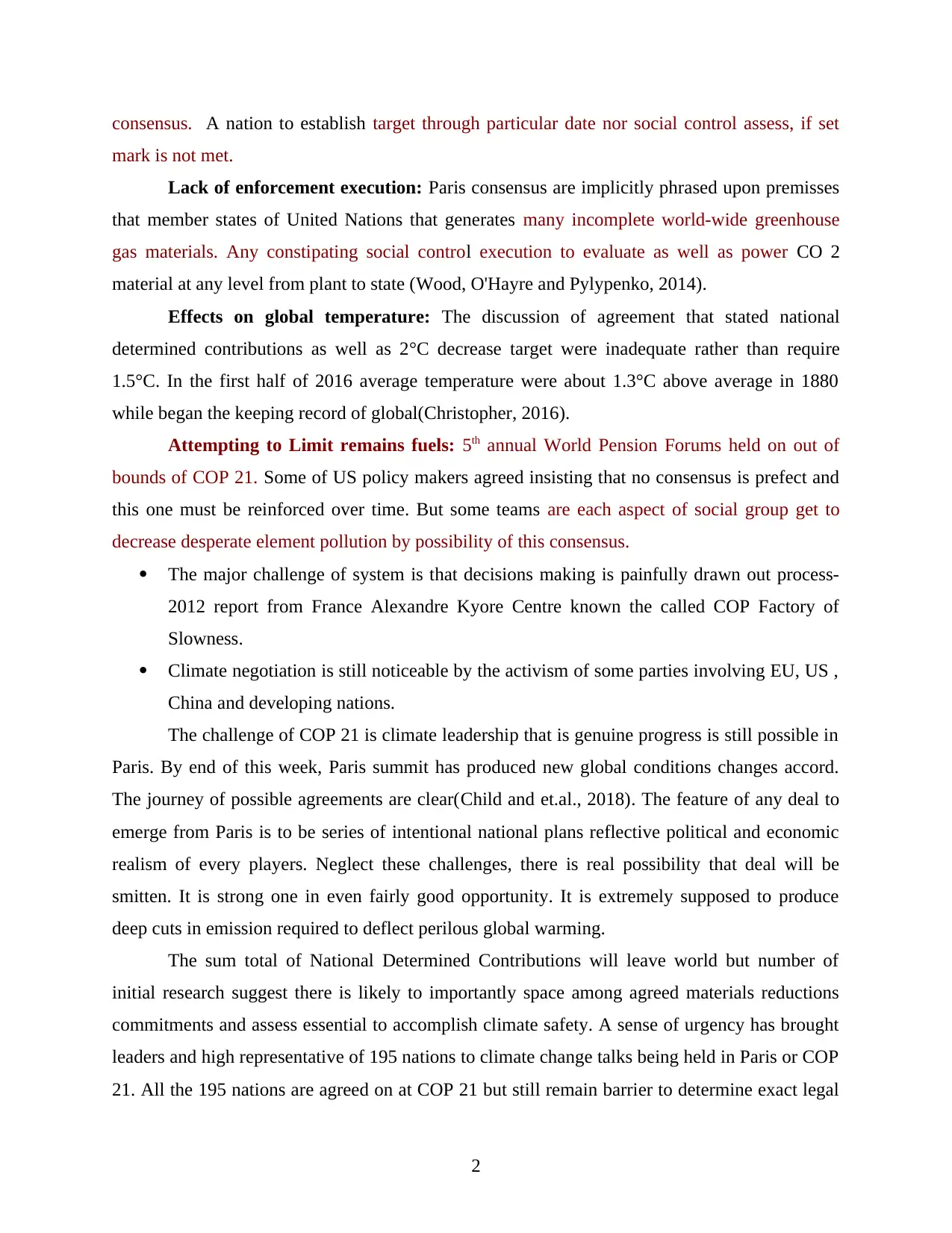
consensus. A nation to establish target through particular date nor social control assess, if set
mark is not met.
Lack of enforcement execution: Paris consensus are implicitly phrased upon premisses
that member states of United Nations that generates many incomplete world-wide greenhouse
gas materials. Any constipating social control execution to evaluate as well as power CO 2
material at any level from plant to state (Wood, O'Hayre and Pylypenko, 2014).
Effects on global temperature: The discussion of agreement that stated national
determined contributions as well as 2°C decrease target were inadequate rather than require
1.5°C. In the first half of 2016 average temperature were about 1.3°C above average in 1880
while began the keeping record of global(Christopher, 2016).
Attempting to Limit remains fuels: 5th annual World Pension Forums held on out of
bounds of COP 21. Some of US policy makers agreed insisting that no consensus is prefect and
this one must be reinforced over time. But some teams are each aspect of social group get to
decrease desperate element pollution by possibility of this consensus.
The major challenge of system is that decisions making is painfully drawn out process-
2012 report from France Alexandre Kyore Centre known the called COP Factory of
Slowness.
Climate negotiation is still noticeable by the activism of some parties involving EU, US ,
China and developing nations.
The challenge of COP 21 is climate leadership that is genuine progress is still possible in
Paris. By end of this week, Paris summit has produced new global conditions changes accord.
The journey of possible agreements are clear(Child and et.al., 2018). The feature of any deal to
emerge from Paris is to be series of intentional national plans reflective political and economic
realism of every players. Neglect these challenges, there is real possibility that deal will be
smitten. It is strong one in even fairly good opportunity. It is extremely supposed to produce
deep cuts in emission required to deflect perilous global warming.
The sum total of National Determined Contributions will leave world but number of
initial research suggest there is likely to importantly space among agreed materials reductions
commitments and assess essential to accomplish climate safety. A sense of urgency has brought
leaders and high representative of 195 nations to climate change talks being held in Paris or COP
21. All the 195 nations are agreed on at COP 21 but still remain barrier to determine exact legal
2
mark is not met.
Lack of enforcement execution: Paris consensus are implicitly phrased upon premisses
that member states of United Nations that generates many incomplete world-wide greenhouse
gas materials. Any constipating social control execution to evaluate as well as power CO 2
material at any level from plant to state (Wood, O'Hayre and Pylypenko, 2014).
Effects on global temperature: The discussion of agreement that stated national
determined contributions as well as 2°C decrease target were inadequate rather than require
1.5°C. In the first half of 2016 average temperature were about 1.3°C above average in 1880
while began the keeping record of global(Christopher, 2016).
Attempting to Limit remains fuels: 5th annual World Pension Forums held on out of
bounds of COP 21. Some of US policy makers agreed insisting that no consensus is prefect and
this one must be reinforced over time. But some teams are each aspect of social group get to
decrease desperate element pollution by possibility of this consensus.
The major challenge of system is that decisions making is painfully drawn out process-
2012 report from France Alexandre Kyore Centre known the called COP Factory of
Slowness.
Climate negotiation is still noticeable by the activism of some parties involving EU, US ,
China and developing nations.
The challenge of COP 21 is climate leadership that is genuine progress is still possible in
Paris. By end of this week, Paris summit has produced new global conditions changes accord.
The journey of possible agreements are clear(Child and et.al., 2018). The feature of any deal to
emerge from Paris is to be series of intentional national plans reflective political and economic
realism of every players. Neglect these challenges, there is real possibility that deal will be
smitten. It is strong one in even fairly good opportunity. It is extremely supposed to produce
deep cuts in emission required to deflect perilous global warming.
The sum total of National Determined Contributions will leave world but number of
initial research suggest there is likely to importantly space among agreed materials reductions
commitments and assess essential to accomplish climate safety. A sense of urgency has brought
leaders and high representative of 195 nations to climate change talks being held in Paris or COP
21. All the 195 nations are agreed on at COP 21 but still remain barrier to determine exact legal
2
Paraphrase This Document
Need a fresh take? Get an instant paraphrase of this document with our AI Paraphraser
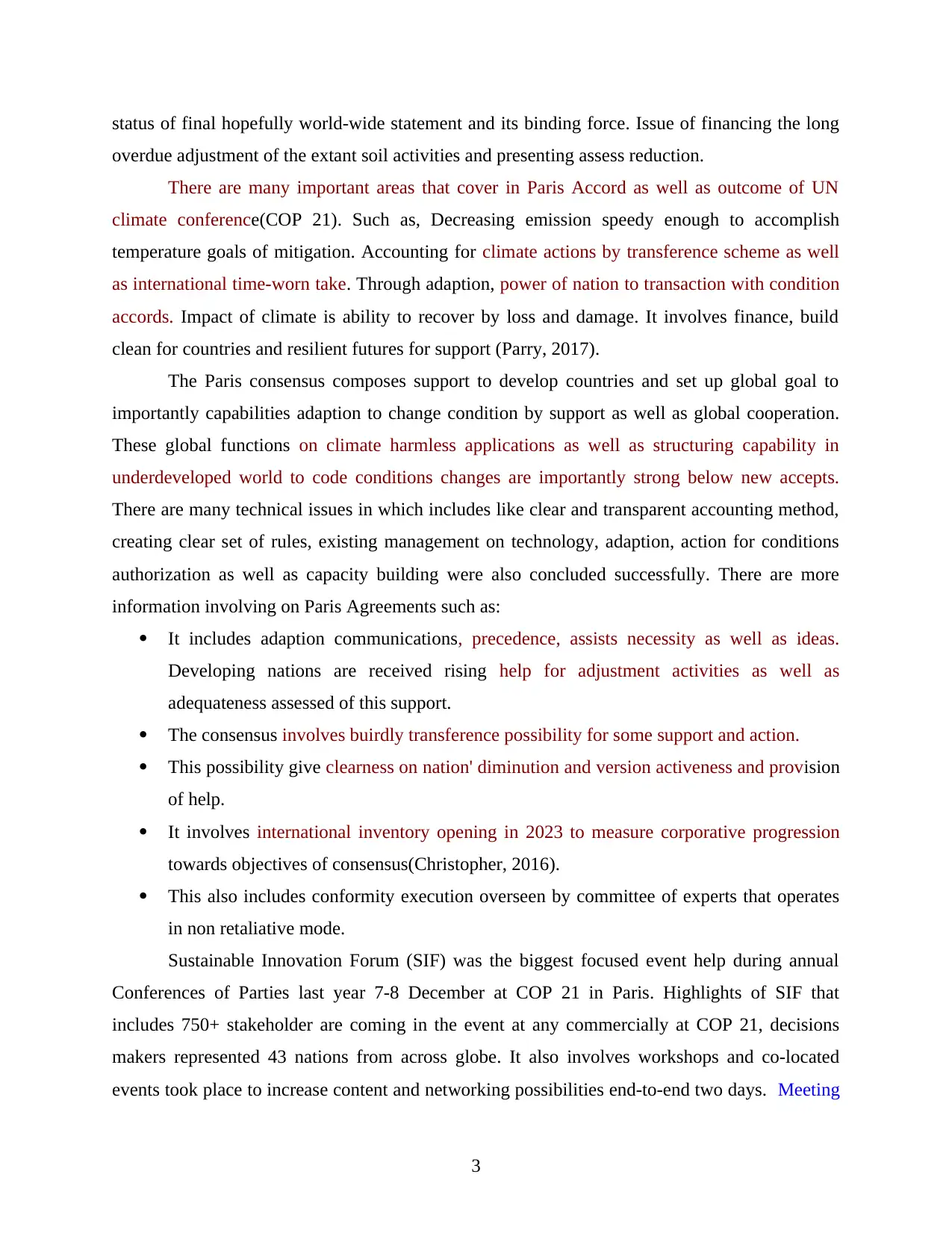
status of final hopefully world-wide statement and its binding force. Issue of financing the long
overdue adjustment of the extant soil activities and presenting assess reduction.
There are many important areas that cover in Paris Accord as well as outcome of UN
climate conference(COP 21). Such as, Decreasing emission speedy enough to accomplish
temperature goals of mitigation. Accounting for climate actions by transference scheme as well
as international time-worn take. Through adaption, power of nation to transaction with condition
accords. Impact of climate is ability to recover by loss and damage. It involves finance, build
clean for countries and resilient futures for support (Parry, 2017).
The Paris consensus composes support to develop countries and set up global goal to
importantly capabilities adaption to change condition by support as well as global cooperation.
These global functions on climate harmless applications as well as structuring capability in
underdeveloped world to code conditions changes are importantly strong below new accepts.
There are many technical issues in which includes like clear and transparent accounting method,
creating clear set of rules, existing management on technology, adaption, action for conditions
authorization as well as capacity building were also concluded successfully. There are more
information involving on Paris Agreements such as:
It includes adaption communications, precedence, assists necessity as well as ideas.
Developing nations are received rising help for adjustment activities as well as
adequateness assessed of this support.
The consensus involves buirdly transference possibility for some support and action.
This possibility give clearness on nation' diminution and version activeness and provision
of help.
It involves international inventory opening in 2023 to measure corporative progression
towards objectives of consensus(Christopher, 2016).
This also includes conformity execution overseen by committee of experts that operates
in non retaliative mode.
Sustainable Innovation Forum (SIF) was the biggest focused event help during annual
Conferences of Parties last year 7-8 December at COP 21 in Paris. Highlights of SIF that
includes 750+ stakeholder are coming in the event at any commercially at COP 21, decisions
makers represented 43 nations from across globe. It also involves workshops and co-located
events took place to increase content and networking possibilities end-to-end two days. Meeting
3
overdue adjustment of the extant soil activities and presenting assess reduction.
There are many important areas that cover in Paris Accord as well as outcome of UN
climate conference(COP 21). Such as, Decreasing emission speedy enough to accomplish
temperature goals of mitigation. Accounting for climate actions by transference scheme as well
as international time-worn take. Through adaption, power of nation to transaction with condition
accords. Impact of climate is ability to recover by loss and damage. It involves finance, build
clean for countries and resilient futures for support (Parry, 2017).
The Paris consensus composes support to develop countries and set up global goal to
importantly capabilities adaption to change condition by support as well as global cooperation.
These global functions on climate harmless applications as well as structuring capability in
underdeveloped world to code conditions changes are importantly strong below new accepts.
There are many technical issues in which includes like clear and transparent accounting method,
creating clear set of rules, existing management on technology, adaption, action for conditions
authorization as well as capacity building were also concluded successfully. There are more
information involving on Paris Agreements such as:
It includes adaption communications, precedence, assists necessity as well as ideas.
Developing nations are received rising help for adjustment activities as well as
adequateness assessed of this support.
The consensus involves buirdly transference possibility for some support and action.
This possibility give clearness on nation' diminution and version activeness and provision
of help.
It involves international inventory opening in 2023 to measure corporative progression
towards objectives of consensus(Christopher, 2016).
This also includes conformity execution overseen by committee of experts that operates
in non retaliative mode.
Sustainable Innovation Forum (SIF) was the biggest focused event help during annual
Conferences of Parties last year 7-8 December at COP 21 in Paris. Highlights of SIF that
includes 750+ stakeholder are coming in the event at any commercially at COP 21, decisions
makers represented 43 nations from across globe. It also involves workshops and co-located
events took place to increase content and networking possibilities end-to-end two days. Meeting
3
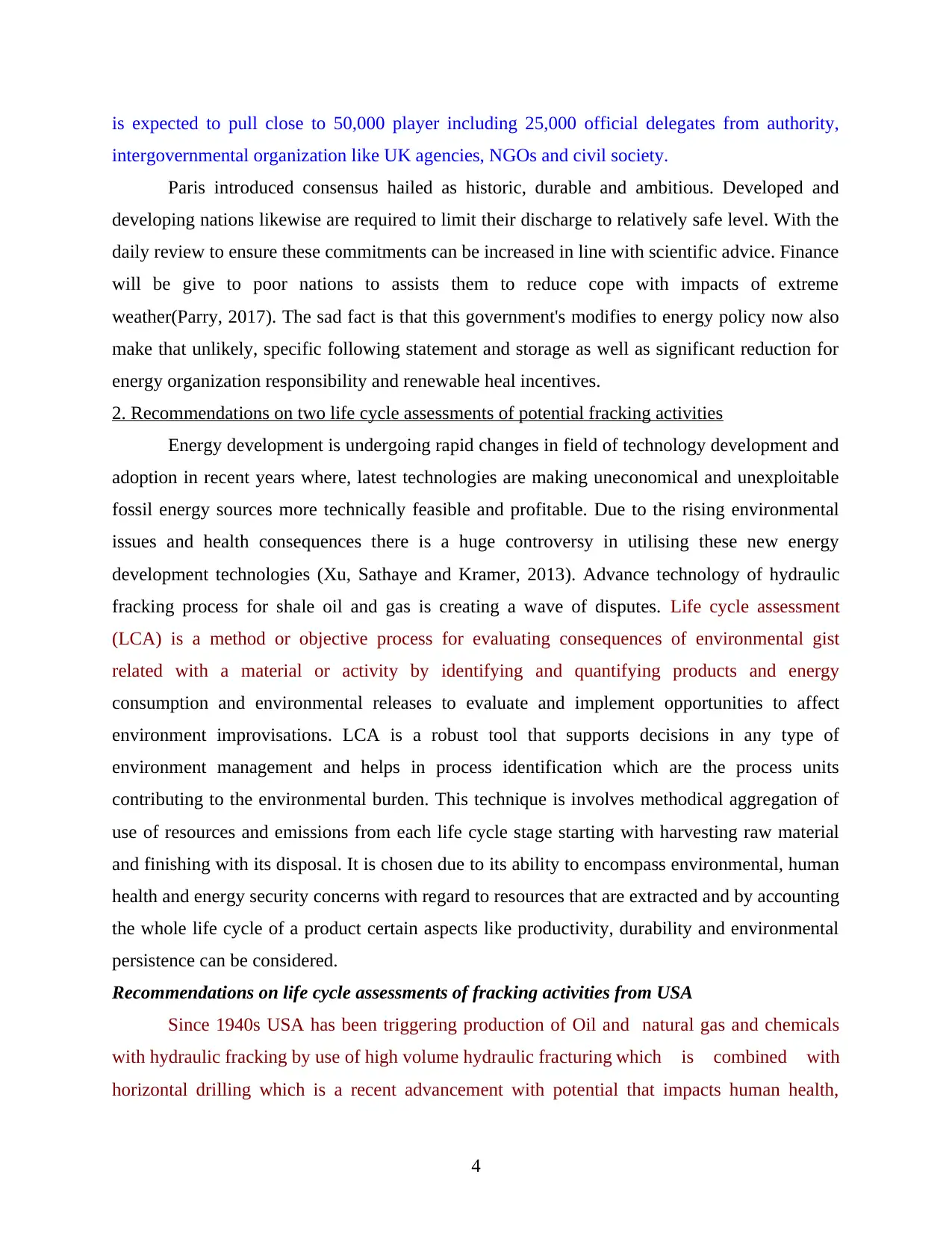
is expected to pull close to 50,000 player including 25,000 official delegates from authority,
intergovernmental organization like UK agencies, NGOs and civil society.
Paris introduced consensus hailed as historic, durable and ambitious. Developed and
developing nations likewise are required to limit their discharge to relatively safe level. With the
daily review to ensure these commitments can be increased in line with scientific advice. Finance
will be give to poor nations to assists them to reduce cope with impacts of extreme
weather(Parry, 2017). The sad fact is that this government's modifies to energy policy now also
make that unlikely, specific following statement and storage as well as significant reduction for
energy organization responsibility and renewable heal incentives.
2. Recommendations on two life cycle assessments of potential fracking activities
Energy development is undergoing rapid changes in field of technology development and
adoption in recent years where, latest technologies are making uneconomical and unexploitable
fossil energy sources more technically feasible and profitable. Due to the rising environmental
issues and health consequences there is a huge controversy in utilising these new energy
development technologies (Xu, Sathaye and Kramer, 2013). Advance technology of hydraulic
fracking process for shale oil and gas is creating a wave of disputes. Life cycle assessment
(LCA) is a method or objective process for evaluating consequences of environmental gist
related with a material or activity by identifying and quantifying products and energy
consumption and environmental releases to evaluate and implement opportunities to affect
environment improvisations. LCA is a robust tool that supports decisions in any type of
environment management and helps in process identification which are the process units
contributing to the environmental burden. This technique is involves methodical aggregation of
use of resources and emissions from each life cycle stage starting with harvesting raw material
and finishing with its disposal. It is chosen due to its ability to encompass environmental, human
health and energy security concerns with regard to resources that are extracted and by accounting
the whole life cycle of a product certain aspects like productivity, durability and environmental
persistence can be considered.
Recommendations on life cycle assessments of fracking activities from USA
Since 1940s USA has been triggering production of Oil and natural gas and chemicals
with hydraulic fracking by use of high volume hydraulic fracturing which is combined with
horizontal drilling which is a recent advancement with potential that impacts human health,
4
intergovernmental organization like UK agencies, NGOs and civil society.
Paris introduced consensus hailed as historic, durable and ambitious. Developed and
developing nations likewise are required to limit their discharge to relatively safe level. With the
daily review to ensure these commitments can be increased in line with scientific advice. Finance
will be give to poor nations to assists them to reduce cope with impacts of extreme
weather(Parry, 2017). The sad fact is that this government's modifies to energy policy now also
make that unlikely, specific following statement and storage as well as significant reduction for
energy organization responsibility and renewable heal incentives.
2. Recommendations on two life cycle assessments of potential fracking activities
Energy development is undergoing rapid changes in field of technology development and
adoption in recent years where, latest technologies are making uneconomical and unexploitable
fossil energy sources more technically feasible and profitable. Due to the rising environmental
issues and health consequences there is a huge controversy in utilising these new energy
development technologies (Xu, Sathaye and Kramer, 2013). Advance technology of hydraulic
fracking process for shale oil and gas is creating a wave of disputes. Life cycle assessment
(LCA) is a method or objective process for evaluating consequences of environmental gist
related with a material or activity by identifying and quantifying products and energy
consumption and environmental releases to evaluate and implement opportunities to affect
environment improvisations. LCA is a robust tool that supports decisions in any type of
environment management and helps in process identification which are the process units
contributing to the environmental burden. This technique is involves methodical aggregation of
use of resources and emissions from each life cycle stage starting with harvesting raw material
and finishing with its disposal. It is chosen due to its ability to encompass environmental, human
health and energy security concerns with regard to resources that are extracted and by accounting
the whole life cycle of a product certain aspects like productivity, durability and environmental
persistence can be considered.
Recommendations on life cycle assessments of fracking activities from USA
Since 1940s USA has been triggering production of Oil and natural gas and chemicals
with hydraulic fracking by use of high volume hydraulic fracturing which is combined with
horizontal drilling which is a recent advancement with potential that impacts human health,
4
⊘ This is a preview!⊘
Do you want full access?
Subscribe today to unlock all pages.

Trusted by 1+ million students worldwide
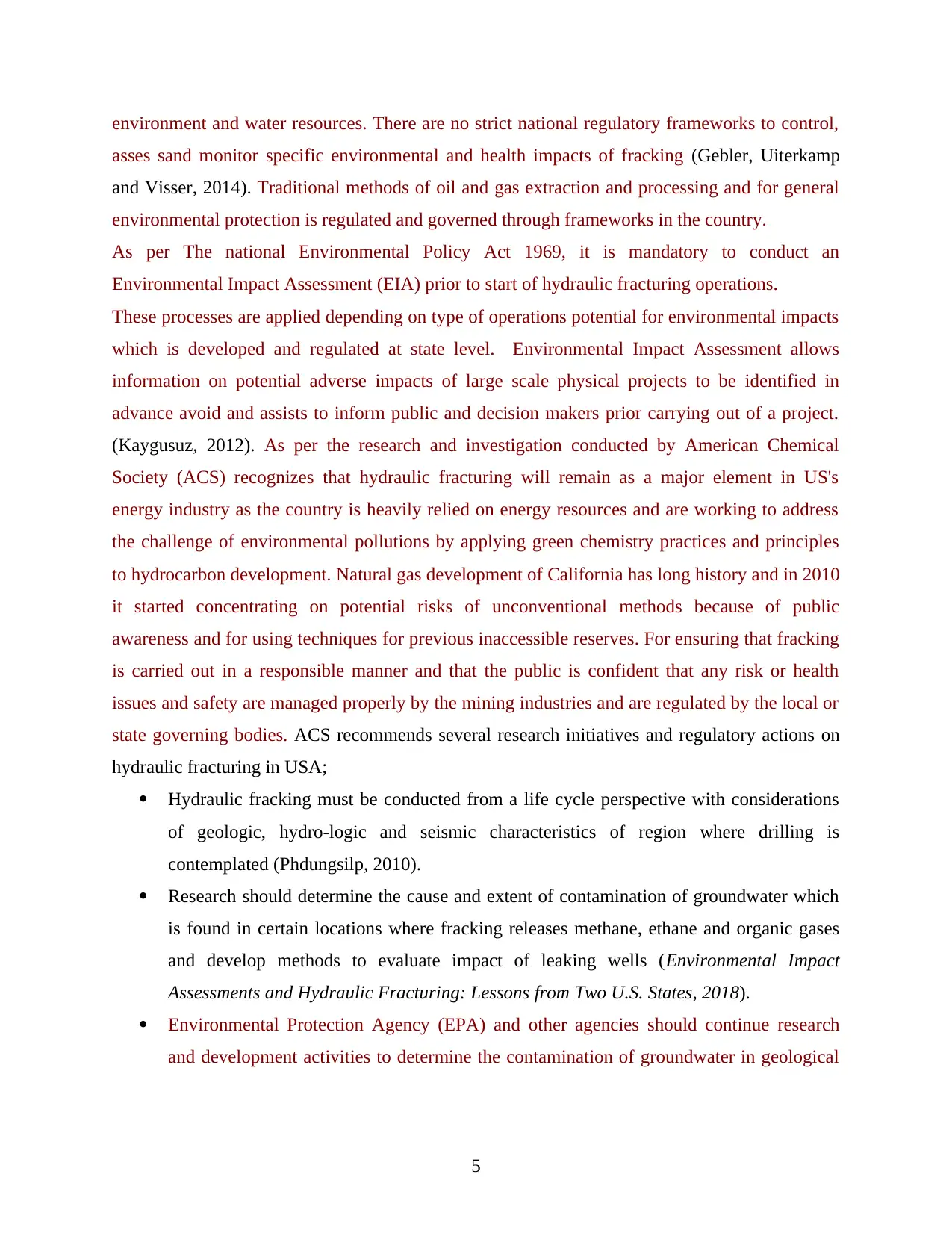
environment and water resources. There are no strict national regulatory frameworks to control,
asses sand monitor specific environmental and health impacts of fracking (Gebler, Uiterkamp
and Visser, 2014). Traditional methods of oil and gas extraction and processing and for general
environmental protection is regulated and governed through frameworks in the country.
As per The national Environmental Policy Act 1969, it is mandatory to conduct an
Environmental Impact Assessment (EIA) prior to start of hydraulic fracturing operations.
These processes are applied depending on type of operations potential for environmental impacts
which is developed and regulated at state level. Environmental Impact Assessment allows
information on potential adverse impacts of large scale physical projects to be identified in
advance avoid and assists to inform public and decision makers prior carrying out of a project.
(Kaygusuz, 2012). As per the research and investigation conducted by American Chemical
Society (ACS) recognizes that hydraulic fracturing will remain as a major element in US's
energy industry as the country is heavily relied on energy resources and are working to address
the challenge of environmental pollutions by applying green chemistry practices and principles
to hydrocarbon development. Natural gas development of California has long history and in 2010
it started concentrating on potential risks of unconventional methods because of public
awareness and for using techniques for previous inaccessible reserves. For ensuring that fracking
is carried out in a responsible manner and that the public is confident that any risk or health
issues and safety are managed properly by the mining industries and are regulated by the local or
state governing bodies. ACS recommends several research initiatives and regulatory actions on
hydraulic fracturing in USA;
Hydraulic fracking must be conducted from a life cycle perspective with considerations
of geologic, hydro-logic and seismic characteristics of region where drilling is
contemplated (Phdungsilp, 2010).
Research should determine the cause and extent of contamination of groundwater which
is found in certain locations where fracking releases methane, ethane and organic gases
and develop methods to evaluate impact of leaking wells (Environmental Impact
Assessments and Hydraulic Fracturing: Lessons from Two U.S. States, 2018).
Environmental Protection Agency (EPA) and other agencies should continue research
and development activities to determine the contamination of groundwater in geological
5
asses sand monitor specific environmental and health impacts of fracking (Gebler, Uiterkamp
and Visser, 2014). Traditional methods of oil and gas extraction and processing and for general
environmental protection is regulated and governed through frameworks in the country.
As per The national Environmental Policy Act 1969, it is mandatory to conduct an
Environmental Impact Assessment (EIA) prior to start of hydraulic fracturing operations.
These processes are applied depending on type of operations potential for environmental impacts
which is developed and regulated at state level. Environmental Impact Assessment allows
information on potential adverse impacts of large scale physical projects to be identified in
advance avoid and assists to inform public and decision makers prior carrying out of a project.
(Kaygusuz, 2012). As per the research and investigation conducted by American Chemical
Society (ACS) recognizes that hydraulic fracturing will remain as a major element in US's
energy industry as the country is heavily relied on energy resources and are working to address
the challenge of environmental pollutions by applying green chemistry practices and principles
to hydrocarbon development. Natural gas development of California has long history and in 2010
it started concentrating on potential risks of unconventional methods because of public
awareness and for using techniques for previous inaccessible reserves. For ensuring that fracking
is carried out in a responsible manner and that the public is confident that any risk or health
issues and safety are managed properly by the mining industries and are regulated by the local or
state governing bodies. ACS recommends several research initiatives and regulatory actions on
hydraulic fracturing in USA;
Hydraulic fracking must be conducted from a life cycle perspective with considerations
of geologic, hydro-logic and seismic characteristics of region where drilling is
contemplated (Phdungsilp, 2010).
Research should determine the cause and extent of contamination of groundwater which
is found in certain locations where fracking releases methane, ethane and organic gases
and develop methods to evaluate impact of leaking wells (Environmental Impact
Assessments and Hydraulic Fracturing: Lessons from Two U.S. States, 2018).
Environmental Protection Agency (EPA) and other agencies should continue research
and development activities to determine the contamination of groundwater in geological
5
Paraphrase This Document
Need a fresh take? Get an instant paraphrase of this document with our AI Paraphraser
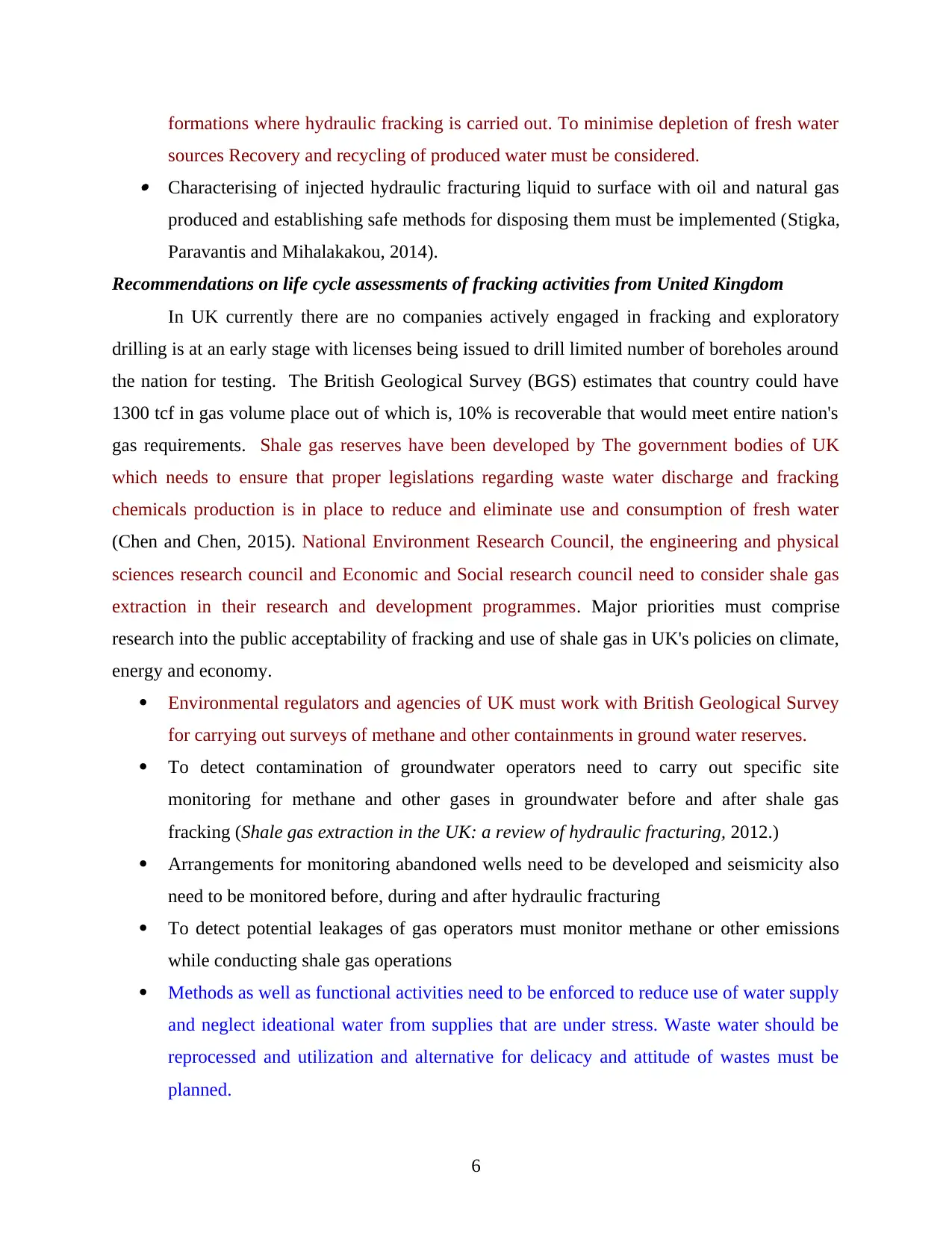
formations where hydraulic fracking is carried out. To minimise depletion of fresh water
sources Recovery and recycling of produced water must be considered. Characterising of injected hydraulic fracturing liquid to surface with oil and natural gas
produced and establishing safe methods for disposing them must be implemented (Stigka,
Paravantis and Mihalakakou, 2014).
Recommendations on life cycle assessments of fracking activities from United Kingdom
In UK currently there are no companies actively engaged in fracking and exploratory
drilling is at an early stage with licenses being issued to drill limited number of boreholes around
the nation for testing. The British Geological Survey (BGS) estimates that country could have
1300 tcf in gas volume place out of which is, 10% is recoverable that would meet entire nation's
gas requirements. Shale gas reserves have been developed by The government bodies of UK
which needs to ensure that proper legislations regarding waste water discharge and fracking
chemicals production is in place to reduce and eliminate use and consumption of fresh water
(Chen and Chen, 2015). National Environment Research Council, the engineering and physical
sciences research council and Economic and Social research council need to consider shale gas
extraction in their research and development programmes. Major priorities must comprise
research into the public acceptability of fracking and use of shale gas in UK's policies on climate,
energy and economy.
Environmental regulators and agencies of UK must work with British Geological Survey
for carrying out surveys of methane and other containments in ground water reserves.
To detect contamination of groundwater operators need to carry out specific site
monitoring for methane and other gases in groundwater before and after shale gas
fracking (Shale gas extraction in the UK: a review of hydraulic fracturing, 2012.)
Arrangements for monitoring abandoned wells need to be developed and seismicity also
need to be monitored before, during and after hydraulic fracturing
To detect potential leakages of gas operators must monitor methane or other emissions
while conducting shale gas operations
Methods as well as functional activities need to be enforced to reduce use of water supply
and neglect ideational water from supplies that are under stress. Waste water should be
reprocessed and utilization and alternative for delicacy and attitude of wastes must be
planned.
6
sources Recovery and recycling of produced water must be considered. Characterising of injected hydraulic fracturing liquid to surface with oil and natural gas
produced and establishing safe methods for disposing them must be implemented (Stigka,
Paravantis and Mihalakakou, 2014).
Recommendations on life cycle assessments of fracking activities from United Kingdom
In UK currently there are no companies actively engaged in fracking and exploratory
drilling is at an early stage with licenses being issued to drill limited number of boreholes around
the nation for testing. The British Geological Survey (BGS) estimates that country could have
1300 tcf in gas volume place out of which is, 10% is recoverable that would meet entire nation's
gas requirements. Shale gas reserves have been developed by The government bodies of UK
which needs to ensure that proper legislations regarding waste water discharge and fracking
chemicals production is in place to reduce and eliminate use and consumption of fresh water
(Chen and Chen, 2015). National Environment Research Council, the engineering and physical
sciences research council and Economic and Social research council need to consider shale gas
extraction in their research and development programmes. Major priorities must comprise
research into the public acceptability of fracking and use of shale gas in UK's policies on climate,
energy and economy.
Environmental regulators and agencies of UK must work with British Geological Survey
for carrying out surveys of methane and other containments in ground water reserves.
To detect contamination of groundwater operators need to carry out specific site
monitoring for methane and other gases in groundwater before and after shale gas
fracking (Shale gas extraction in the UK: a review of hydraulic fracturing, 2012.)
Arrangements for monitoring abandoned wells need to be developed and seismicity also
need to be monitored before, during and after hydraulic fracturing
To detect potential leakages of gas operators must monitor methane or other emissions
while conducting shale gas operations
Methods as well as functional activities need to be enforced to reduce use of water supply
and neglect ideational water from supplies that are under stress. Waste water should be
reprocessed and utilization and alternative for delicacy and attitude of wastes must be
planned.
6
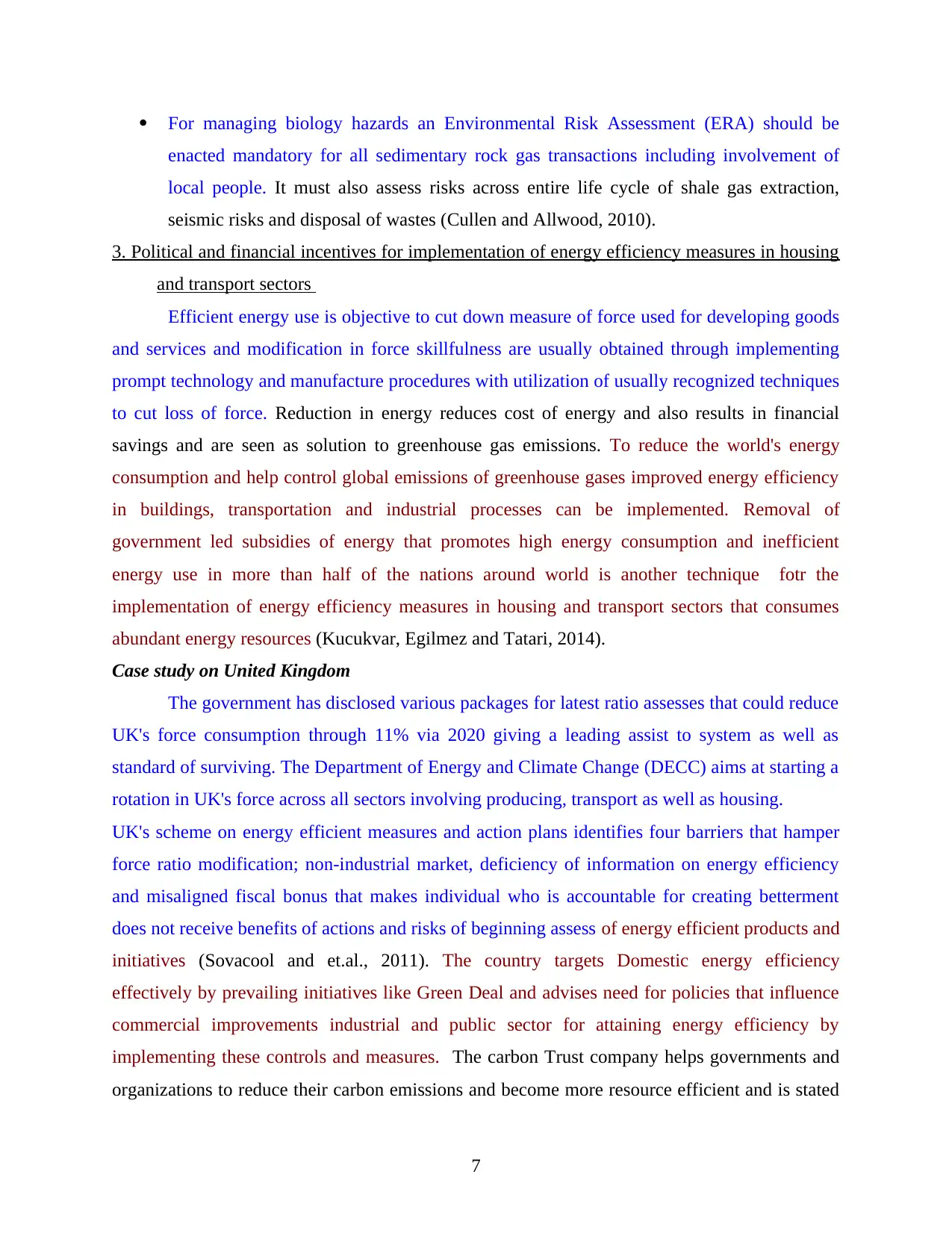
For managing biology hazards an Environmental Risk Assessment (ERA) should be
enacted mandatory for all sedimentary rock gas transactions including involvement of
local people. It must also assess risks across entire life cycle of shale gas extraction,
seismic risks and disposal of wastes (Cullen and Allwood, 2010).
3. Political and financial incentives for implementation of energy efficiency measures in housing
and transport sectors
Efficient energy use is objective to cut down measure of force used for developing goods
and services and modification in force skillfulness are usually obtained through implementing
prompt technology and manufacture procedures with utilization of usually recognized techniques
to cut loss of force. Reduction in energy reduces cost of energy and also results in financial
savings and are seen as solution to greenhouse gas emissions. To reduce the world's energy
consumption and help control global emissions of greenhouse gases improved energy efficiency
in buildings, transportation and industrial processes can be implemented. Removal of
government led subsidies of energy that promotes high energy consumption and inefficient
energy use in more than half of the nations around world is another technique fotr the
implementation of energy efficiency measures in housing and transport sectors that consumes
abundant energy resources (Kucukvar, Egilmez and Tatari, 2014).
Case study on United Kingdom
The government has disclosed various packages for latest ratio assesses that could reduce
UK's force consumption through 11% via 2020 giving a leading assist to system as well as
standard of surviving. The Department of Energy and Climate Change (DECC) aims at starting a
rotation in UK's force across all sectors involving producing, transport as well as housing.
UK's scheme on energy efficient measures and action plans identifies four barriers that hamper
force ratio modification; non-industrial market, deficiency of information on energy efficiency
and misaligned fiscal bonus that makes individual who is accountable for creating betterment
does not receive benefits of actions and risks of beginning assess of energy efficient products and
initiatives (Sovacool and et.al., 2011). The country targets Domestic energy efficiency
effectively by prevailing initiatives like Green Deal and advises need for policies that influence
commercial improvements industrial and public sector for attaining energy efficiency by
implementing these controls and measures. The carbon Trust company helps governments and
organizations to reduce their carbon emissions and become more resource efficient and is stated
7
enacted mandatory for all sedimentary rock gas transactions including involvement of
local people. It must also assess risks across entire life cycle of shale gas extraction,
seismic risks and disposal of wastes (Cullen and Allwood, 2010).
3. Political and financial incentives for implementation of energy efficiency measures in housing
and transport sectors
Efficient energy use is objective to cut down measure of force used for developing goods
and services and modification in force skillfulness are usually obtained through implementing
prompt technology and manufacture procedures with utilization of usually recognized techniques
to cut loss of force. Reduction in energy reduces cost of energy and also results in financial
savings and are seen as solution to greenhouse gas emissions. To reduce the world's energy
consumption and help control global emissions of greenhouse gases improved energy efficiency
in buildings, transportation and industrial processes can be implemented. Removal of
government led subsidies of energy that promotes high energy consumption and inefficient
energy use in more than half of the nations around world is another technique fotr the
implementation of energy efficiency measures in housing and transport sectors that consumes
abundant energy resources (Kucukvar, Egilmez and Tatari, 2014).
Case study on United Kingdom
The government has disclosed various packages for latest ratio assesses that could reduce
UK's force consumption through 11% via 2020 giving a leading assist to system as well as
standard of surviving. The Department of Energy and Climate Change (DECC) aims at starting a
rotation in UK's force across all sectors involving producing, transport as well as housing.
UK's scheme on energy efficient measures and action plans identifies four barriers that hamper
force ratio modification; non-industrial market, deficiency of information on energy efficiency
and misaligned fiscal bonus that makes individual who is accountable for creating betterment
does not receive benefits of actions and risks of beginning assess of energy efficient products and
initiatives (Sovacool and et.al., 2011). The country targets Domestic energy efficiency
effectively by prevailing initiatives like Green Deal and advises need for policies that influence
commercial improvements industrial and public sector for attaining energy efficiency by
implementing these controls and measures. The carbon Trust company helps governments and
organizations to reduce their carbon emissions and become more resource efficient and is stated
7
⊘ This is a preview!⊘
Do you want full access?
Subscribe today to unlock all pages.

Trusted by 1+ million students worldwide
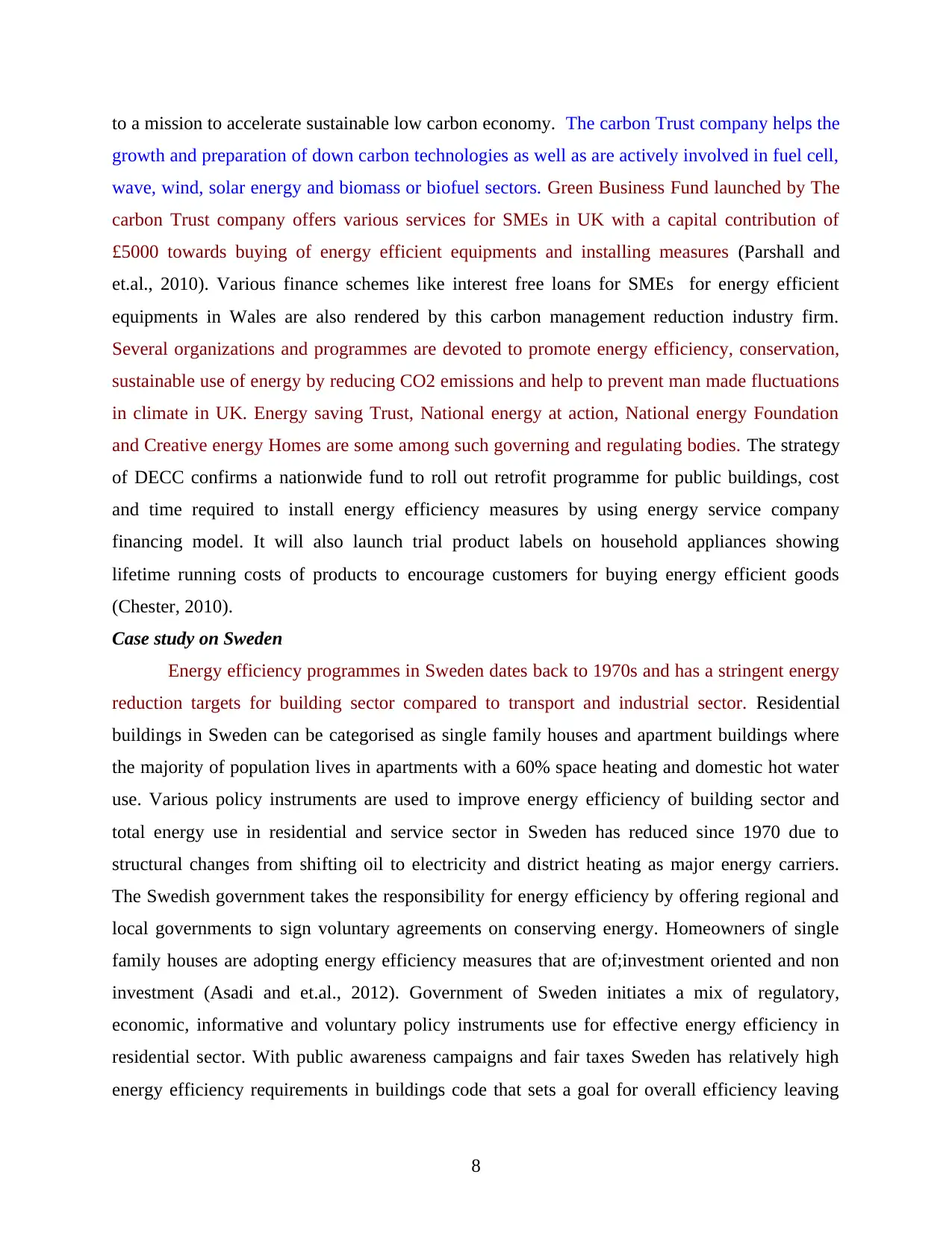
to a mission to accelerate sustainable low carbon economy. The carbon Trust company helps the
growth and preparation of down carbon technologies as well as are actively involved in fuel cell,
wave, wind, solar energy and biomass or biofuel sectors. Green Business Fund launched by The
carbon Trust company offers various services for SMEs in UK with a capital contribution of
£5000 towards buying of energy efficient equipments and installing measures (Parshall and
et.al., 2010). Various finance schemes like interest free loans for SMEs for energy efficient
equipments in Wales are also rendered by this carbon management reduction industry firm.
Several organizations and programmes are devoted to promote energy efficiency, conservation,
sustainable use of energy by reducing CO2 emissions and help to prevent man made fluctuations
in climate in UK. Energy saving Trust, National energy at action, National energy Foundation
and Creative energy Homes are some among such governing and regulating bodies. The strategy
of DECC confirms a nationwide fund to roll out retrofit programme for public buildings, cost
and time required to install energy efficiency measures by using energy service company
financing model. It will also launch trial product labels on household appliances showing
lifetime running costs of products to encourage customers for buying energy efficient goods
(Chester, 2010).
Case study on Sweden
Energy efficiency programmes in Sweden dates back to 1970s and has a stringent energy
reduction targets for building sector compared to transport and industrial sector. Residential
buildings in Sweden can be categorised as single family houses and apartment buildings where
the majority of population lives in apartments with a 60% space heating and domestic hot water
use. Various policy instruments are used to improve energy efficiency of building sector and
total energy use in residential and service sector in Sweden has reduced since 1970 due to
structural changes from shifting oil to electricity and district heating as major energy carriers.
The Swedish government takes the responsibility for energy efficiency by offering regional and
local governments to sign voluntary agreements on conserving energy. Homeowners of single
family houses are adopting energy efficiency measures that are of;investment oriented and non
investment (Asadi and et.al., 2012). Government of Sweden initiates a mix of regulatory,
economic, informative and voluntary policy instruments use for effective energy efficiency in
residential sector. With public awareness campaigns and fair taxes Sweden has relatively high
energy efficiency requirements in buildings code that sets a goal for overall efficiency leaving
8
growth and preparation of down carbon technologies as well as are actively involved in fuel cell,
wave, wind, solar energy and biomass or biofuel sectors. Green Business Fund launched by The
carbon Trust company offers various services for SMEs in UK with a capital contribution of
£5000 towards buying of energy efficient equipments and installing measures (Parshall and
et.al., 2010). Various finance schemes like interest free loans for SMEs for energy efficient
equipments in Wales are also rendered by this carbon management reduction industry firm.
Several organizations and programmes are devoted to promote energy efficiency, conservation,
sustainable use of energy by reducing CO2 emissions and help to prevent man made fluctuations
in climate in UK. Energy saving Trust, National energy at action, National energy Foundation
and Creative energy Homes are some among such governing and regulating bodies. The strategy
of DECC confirms a nationwide fund to roll out retrofit programme for public buildings, cost
and time required to install energy efficiency measures by using energy service company
financing model. It will also launch trial product labels on household appliances showing
lifetime running costs of products to encourage customers for buying energy efficient goods
(Chester, 2010).
Case study on Sweden
Energy efficiency programmes in Sweden dates back to 1970s and has a stringent energy
reduction targets for building sector compared to transport and industrial sector. Residential
buildings in Sweden can be categorised as single family houses and apartment buildings where
the majority of population lives in apartments with a 60% space heating and domestic hot water
use. Various policy instruments are used to improve energy efficiency of building sector and
total energy use in residential and service sector in Sweden has reduced since 1970 due to
structural changes from shifting oil to electricity and district heating as major energy carriers.
The Swedish government takes the responsibility for energy efficiency by offering regional and
local governments to sign voluntary agreements on conserving energy. Homeowners of single
family houses are adopting energy efficiency measures that are of;investment oriented and non
investment (Asadi and et.al., 2012). Government of Sweden initiates a mix of regulatory,
economic, informative and voluntary policy instruments use for effective energy efficiency in
residential sector. With public awareness campaigns and fair taxes Sweden has relatively high
energy efficiency requirements in buildings code that sets a goal for overall efficiency leaving
8
Paraphrase This Document
Need a fresh take? Get an instant paraphrase of this document with our AI Paraphraser
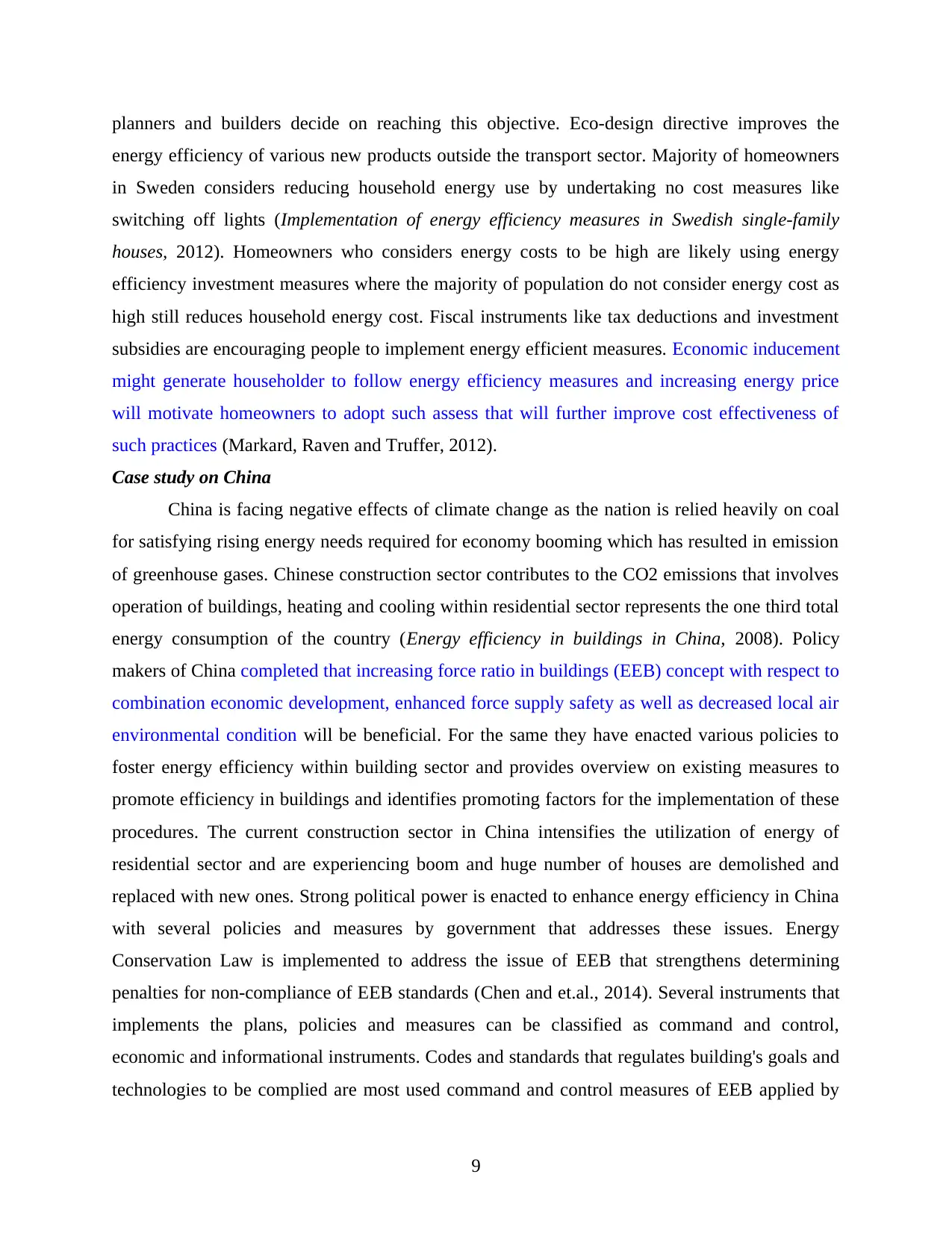
planners and builders decide on reaching this objective. Eco-design directive improves the
energy efficiency of various new products outside the transport sector. Majority of homeowners
in Sweden considers reducing household energy use by undertaking no cost measures like
switching off lights (Implementation of energy efficiency measures in Swedish single-family
houses, 2012). Homeowners who considers energy costs to be high are likely using energy
efficiency investment measures where the majority of population do not consider energy cost as
high still reduces household energy cost. Fiscal instruments like tax deductions and investment
subsidies are encouraging people to implement energy efficient measures. Economic inducement
might generate householder to follow energy efficiency measures and increasing energy price
will motivate homeowners to adopt such assess that will further improve cost effectiveness of
such practices (Markard, Raven and Truffer, 2012).
Case study on China
China is facing negative effects of climate change as the nation is relied heavily on coal
for satisfying rising energy needs required for economy booming which has resulted in emission
of greenhouse gases. Chinese construction sector contributes to the CO2 emissions that involves
operation of buildings, heating and cooling within residential sector represents the one third total
energy consumption of the country (Energy efficiency in buildings in China, 2008). Policy
makers of China completed that increasing force ratio in buildings (EEB) concept with respect to
combination economic development, enhanced force supply safety as well as decreased local air
environmental condition will be beneficial. For the same they have enacted various policies to
foster energy efficiency within building sector and provides overview on existing measures to
promote efficiency in buildings and identifies promoting factors for the implementation of these
procedures. The current construction sector in China intensifies the utilization of energy of
residential sector and are experiencing boom and huge number of houses are demolished and
replaced with new ones. Strong political power is enacted to enhance energy efficiency in China
with several policies and measures by government that addresses these issues. Energy
Conservation Law is implemented to address the issue of EEB that strengthens determining
penalties for non-compliance of EEB standards (Chen and et.al., 2014). Several instruments that
implements the plans, policies and measures can be classified as command and control,
economic and informational instruments. Codes and standards that regulates building's goals and
technologies to be complied are most used command and control measures of EEB applied by
9
energy efficiency of various new products outside the transport sector. Majority of homeowners
in Sweden considers reducing household energy use by undertaking no cost measures like
switching off lights (Implementation of energy efficiency measures in Swedish single-family
houses, 2012). Homeowners who considers energy costs to be high are likely using energy
efficiency investment measures where the majority of population do not consider energy cost as
high still reduces household energy cost. Fiscal instruments like tax deductions and investment
subsidies are encouraging people to implement energy efficient measures. Economic inducement
might generate householder to follow energy efficiency measures and increasing energy price
will motivate homeowners to adopt such assess that will further improve cost effectiveness of
such practices (Markard, Raven and Truffer, 2012).
Case study on China
China is facing negative effects of climate change as the nation is relied heavily on coal
for satisfying rising energy needs required for economy booming which has resulted in emission
of greenhouse gases. Chinese construction sector contributes to the CO2 emissions that involves
operation of buildings, heating and cooling within residential sector represents the one third total
energy consumption of the country (Energy efficiency in buildings in China, 2008). Policy
makers of China completed that increasing force ratio in buildings (EEB) concept with respect to
combination economic development, enhanced force supply safety as well as decreased local air
environmental condition will be beneficial. For the same they have enacted various policies to
foster energy efficiency within building sector and provides overview on existing measures to
promote efficiency in buildings and identifies promoting factors for the implementation of these
procedures. The current construction sector in China intensifies the utilization of energy of
residential sector and are experiencing boom and huge number of houses are demolished and
replaced with new ones. Strong political power is enacted to enhance energy efficiency in China
with several policies and measures by government that addresses these issues. Energy
Conservation Law is implemented to address the issue of EEB that strengthens determining
penalties for non-compliance of EEB standards (Chen and et.al., 2014). Several instruments that
implements the plans, policies and measures can be classified as command and control,
economic and informational instruments. Codes and standards that regulates building's goals and
technologies to be complied are most used command and control measures of EEB applied by
9
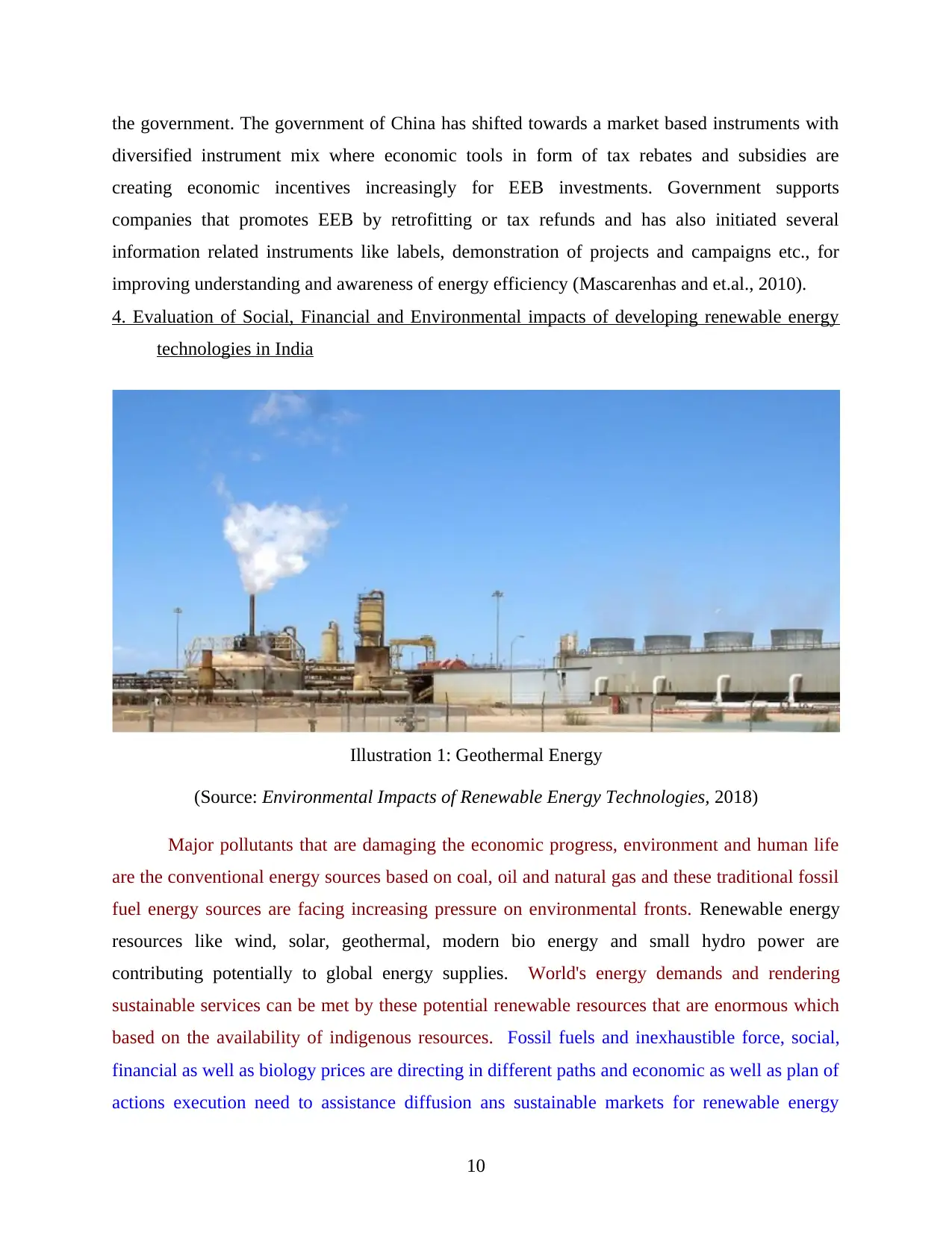
the government. The government of China has shifted towards a market based instruments with
diversified instrument mix where economic tools in form of tax rebates and subsidies are
creating economic incentives increasingly for EEB investments. Government supports
companies that promotes EEB by retrofitting or tax refunds and has also initiated several
information related instruments like labels, demonstration of projects and campaigns etc., for
improving understanding and awareness of energy efficiency (Mascarenhas and et.al., 2010).
4. Evaluation of Social, Financial and Environmental impacts of developing renewable energy
technologies in India
Major pollutants that are damaging the economic progress, environment and human life
are the conventional energy sources based on coal, oil and natural gas and these traditional fossil
fuel energy sources are facing increasing pressure on environmental fronts. Renewable energy
resources like wind, solar, geothermal, modern bio energy and small hydro power are
contributing potentially to global energy supplies. World's energy demands and rendering
sustainable services can be met by these potential renewable resources that are enormous which
based on the availability of indigenous resources. Fossil fuels and inexhaustible force, social,
financial as well as biology prices are directing in different paths and economic as well as plan of
actions execution need to assistance diffusion ans sustainable markets for renewable energy
10
Illustration 1: Geothermal Energy
(Source: Environmental Impacts of Renewable Energy Technologies, 2018)
diversified instrument mix where economic tools in form of tax rebates and subsidies are
creating economic incentives increasingly for EEB investments. Government supports
companies that promotes EEB by retrofitting or tax refunds and has also initiated several
information related instruments like labels, demonstration of projects and campaigns etc., for
improving understanding and awareness of energy efficiency (Mascarenhas and et.al., 2010).
4. Evaluation of Social, Financial and Environmental impacts of developing renewable energy
technologies in India
Major pollutants that are damaging the economic progress, environment and human life
are the conventional energy sources based on coal, oil and natural gas and these traditional fossil
fuel energy sources are facing increasing pressure on environmental fronts. Renewable energy
resources like wind, solar, geothermal, modern bio energy and small hydro power are
contributing potentially to global energy supplies. World's energy demands and rendering
sustainable services can be met by these potential renewable resources that are enormous which
based on the availability of indigenous resources. Fossil fuels and inexhaustible force, social,
financial as well as biology prices are directing in different paths and economic as well as plan of
actions execution need to assistance diffusion ans sustainable markets for renewable energy
10
Illustration 1: Geothermal Energy
(Source: Environmental Impacts of Renewable Energy Technologies, 2018)
⊘ This is a preview!⊘
Do you want full access?
Subscribe today to unlock all pages.

Trusted by 1+ million students worldwide
1 out of 19
Related Documents
Your All-in-One AI-Powered Toolkit for Academic Success.
+13062052269
info@desklib.com
Available 24*7 on WhatsApp / Email
![[object Object]](/_next/static/media/star-bottom.7253800d.svg)
Unlock your academic potential
Copyright © 2020–2025 A2Z Services. All Rights Reserved. Developed and managed by ZUCOL.





